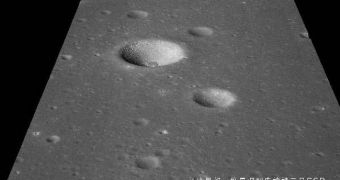Though launched just a month ago, the Chinese Chang'e 2 space probe has already began sending back images of the Moon, experts at the China National Space Administration (CNSA) announce.
The goal of the new spacecraft is to spend more than 6 months conducting operations in lunar orbit, while at the same time scouting out the most appropriate location for a future robotic lander, that the nation plans to deploy in 2013.
Similar to how the Lunar Reconnaissance Orbiter (LRO) was used to detect spots for future manned missions to the Moon, the Chinese spacecraft needs to create maps of the lunar soil, and determine which area would be best for a landing.
The space probe took its first pictures at the end of last month, after being launched on October 1 from the Xichang Satellite Launch Center, aboard a Long March 3C delivery system.
Chang'e 2 features a large variety of scientific instruments including improved stereo Charge-Coupled Device (CCD) cameras, a laser altimeter, a microwave detector, and two spectrometers, one for X-rays and one for gamma-rays, Space reports.
CNSA officials posted five of the images collected by the spacecraft on the China Lunar Exploration Program website, and released one of the them to the media yesterday, on November 8.
The main target for investigation was an area known as Sinus Iridium (or the Bay of Rainbows), which is located in the Moon's northern hemisphere. The region has been evidenced to be relatively flat, with rather few craters and other notable landscape features.
Regardless, the images were showcased in Beijing by Chinese Premier Wen Jiabao. According to the state-run Xinhua news agency, Vice Premier Zhang Dejiang also participated at the ceremony.
“The success of Chang'e 2 in accomplishing its mission marks another great achievement after the country successfully launched its first lunar probe,” Zhang said in a statement.
“The Chinese people will unswervingly develop technologies for the exploration of deep space and the peaceful use of outer space,” he added at the ceremony.
CNSA has big expectations from its space exploration program. China wants to carry out a sample-return flight to Earth's natural satellite by 2017, and then maybe land a manned mission on the lunar surface by 2020.
In the mean time, the country is pushing ahead with constructing its own space station in low-Earth orbit, whose assembly will begin soon. When completed, it will be the third largest in the world ever, after the ISS and the Russian-built Mir.

 14 DAY TRIAL //
14 DAY TRIAL //